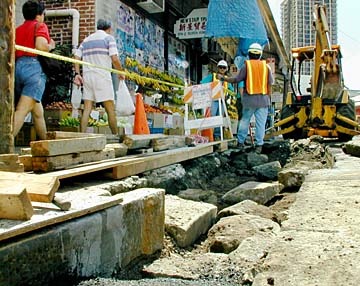




By Ken Ige, Star-Bulletin
Curbs go deep into the ground and don't
end where they appear to.
 Road crews are digging up King Street and doing that mysterious underground stuff that seems to take forever. Whilst they do so, however, it gives us a chance to look down into the layer cake that lies beneath the roadway.
Road crews are digging up King Street and doing that mysterious underground stuff that seems to take forever. Whilst they do so, however, it gives us a chance to look down into the layer cake that lies beneath the roadway.Interestingly, it shows that the curbstones extend down into the ground. Instead of simply being markers that define the edge of the street, it turns out that curbstones are an integral part of the road's construction, and probably predate good-sized chunks of the road.
Before paved roads became the norm -- raise your hand if you already knew "macadam" roads were named after a Scottish asphalt engineer John McAdam -- roads were trails marked off in the wilderness. The Romans figured out that roads could be more efficient if they were hard and flat and straight lines, with the center "crowned" so that water could run off.
The water would go into ditches on either side of the road. The dirt from the parallel ditches was piled in the center, elevating the road from the rest of the landscape and giving us the term "highway." Roads that were privately owned were "byways."
At any rate, the curbstone in the modern city acts like the banks of a river, keeping the flow in one place, and keeping it moving. Because the stones go down, anchoring them in one place, city streets tend not to change unless the curbstones are ripped out and replaced. Even so, on many city streets, the curbstones are the oldest pieces of construction on the block. Think of that next time you trip over one -- you aren't the first to do so.
Curious about something you've seen? Ask us: WatDat?, Honolulu Star-Bulletin, P.O. Box 3080, Honolulu, Hi, fax at 523-7863 or e-mail at features@starbulletin.com.
Today -- Hui O Laulima answers questions about sweet potato mochi making and offers some samples.Funds raised will help the Japanese American National Museum to send the exhibition, "From Bento to Mixed Plate: Americans of Japanese Ancestry in Multicultural Hawaii" to Okinawa in fall 2000.
Tomorrow -- Charles Goodin talks about Hawaii's early Okinawan karate sensei, or teachers, and how they were instrumental in passing on traditions of Okinawan dance, calligraphy, poetry and music.
Wednesday -- Grant Murata talks about Okinawan musical implements.
Thursday -- On Veterans Day, Takejiro Higa honors "local boys who looked like the enemy" in his talk, "Military Intelligence Service, Okinawa 1945."
Friday -- Meet artists Clayton Amemiya, Stephan Doi, Chalres Higa, Ed Higa, Hanae Uechi Mills, Seikichi Takara and Morris Umeno, whose works are on view in the Kakaako Conference Room from 10 a.m. to 8 p.m. daily during the Chirabayo! celebration.
Saturday -- Free festival from 10 a.m. to 5 p.m. features paranku drummers, Okinawan costumes, song and dance performances and sample andagi (doughnuts).

KONG 570-AM / 93.5 FM: Adult contemporary rock with some Hawaiian music
KSSK 590-AM / 92.3-FM: Adult contemporary music
KHNR 650-AM: All news
KQMQ 690-AM / 93.1-FM: Contemporary hits
KGU 760-AM: Sports radio
KHVH 830-AM: News, talk, traffic, weather
KAIM 870-AM / 95.5-FM: Christian music and teaching
KJPN 940-AM: Japanese-language news, adult contemporary music and talk shows
KIKI 990-AM / 93.9-FM: Contemporary country AM; contemporary hits FM
KLHT 1040-AM: Christian radio
KWAI 1080-AM: Talk radio
KZOO 1210-AM: Japanese-language, broadcasts from Japan
KNDI 1270-AM: Live news and programs from the Philippines in 10 languages
KIFO 1380-AM: News, public affairs
KCCN 1420-AM / 100.3-FM: All talk / UH sports AM; contemporary island hits, FM
KUMU 1500-AM / 94.7-FM: Adult standards, AM; light favorites, FM
KHPR 88.1-FM: Classical, news, public affairs
KIPO 89.3-FM: Jazz, classical, news
KTUH 90.3-FM: Jazz, blues, Hawaiian, rock, countryand alternative
KKUA 90.7-FM: Classical, news and public affairs
KKCR 90.9 / 91.9-FM: Hawaiian music, midnight-3 p.m.; and rock, reggae, classical and new age
KRTR 96.3-FM: Adult contemporary music and news
KPOI 97.5-FM: Modern rock
KKLV 98.5-FM: Contemporary Hawaiian
KORL 99.5-FM: Adult contemporary
STAR 101.9-FM: Modern hits
KKHN 102.7-FM: Country
KXME 104.3-FM: Top 40
KINE 105.1-FM: Hawaiian
KGMZ 107.9-FM: Oldies
